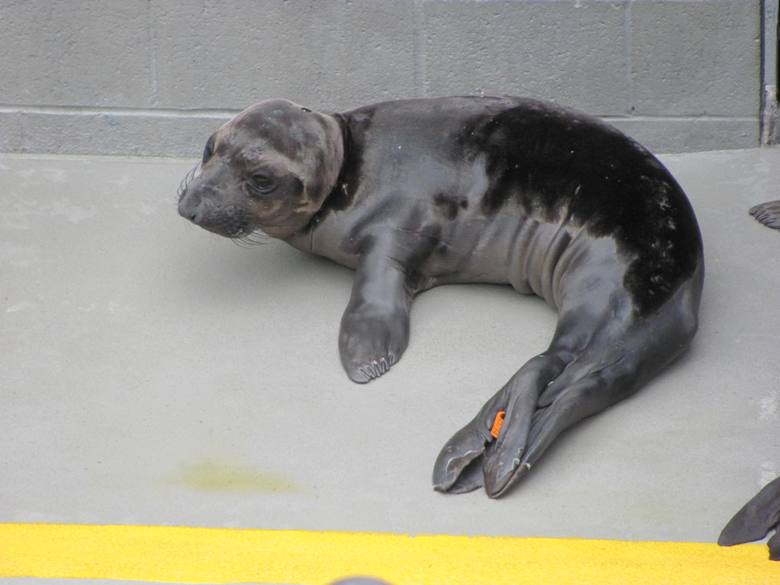A visit to the Marine Mammal Center, where they rescue creatures large and small


DAY 4 — What a big baby—literally.
The elephant seals weigh 75 pounds when they’re born and now, a little more than a month later, these guys should weigh more than 300 pounds.
The pups are unlucky and lucky at the same time. They ended up stranded on a Northern California beach, left by their moms who needed to find food but not adept enough yet to sustain themselves. They are lucky because they ended up here at the Marine Mammal Center (www.marinemammalcenter.org ) in Sausalito just over the Golden Gate Bridge from San Francisco—the largest such rescue facility in the world. The 45 member staff and 800-plus volunteers here are responsible for rescuing some 800 animals a year—elephant seals, sea lions, harbor seals, the occasional whale and dolphin. People who spot a stranded or sick animal call (415-289-7325) and the staff mobilizes for a rescue. The center is responsible for 600 miles of Coast all the way from Mendocino south to San Luis Obispo.
This is a wonderful place to visit. (Full disclosure—my daughter Reggie is working as an AmeriCorps volunteer here this year). There’s no charge and the work they do is amazing.
The windswept day we visited, there were 25 patients (yes this is a full hospital with vets who do detailed blood work, x-rays, ultra sounds and keep copious records that have made this Center respected for the research it has done.)
There are 3 California Sea Lions, 2 harbor seals and 18 elephant seal pups. We learned three more elephant seals are on their way. Last year, 414 animals were released back in the wild—eight released this year. That is the goal, of course. About 50 per cent survive and are able to be released.
Some can’t go back, though. Silent Knight—so named because he was found before the holidays—was shot in the face and blinded. The Center is looking for a zoo for him. There have been famous rescues too—like Chippy, the California sea lion found shot 60 miles from the ocean who jumped up on a California Highway Patrol Car. He recovered and was released.
In case you are wondering about the difference between seals and sea lions, my daughter who does education programs for the center explains that sea lions are like lions—they have ear flaps and big front flippers that allow them to walk on land. Seals are more like sausages who just scoot on land.
This is coming into the busy season here because the elephant seal pupping season has just ended (February) while the harbor seals are born in late march and April and sea lions in June.
While the elephant seal pups typically end up here because of maternal separation and are malnourished, other animals come with a variety of problems—everything from cancer to bacterial infections to getting shot to getting tangled in fishing net or a plastic strap or ingesting a plastic bag. Sadly, eight to 10 per cent of the animals that end up here are injured through human interaction and part of the mission is to show visitors – typically 100 every weekend—the impact our actions have on these remarkable creatures.
Doing something little like picking up trash we see along the beach can save an animal from ending up here. There are remarkable survivor stories with adorable pictures to prove it. Theo the elephant seal who survived a nearly fatal shark attack thanks to surgery; Artemis the stellar sea lion rescued and then seven years later, spotted with her own pup. (When some animals are released, they are tagged with satellite or radio trackers so researchers can see what happens to them.
The center has been here since 1975 but just moved to this facility a couple of years ago. In that time, they’ve rescued over 13,000 animals and developed marine mammal research technology providing expertise on marine mammal illness, even how to administer antibiotics to humpback whales and perhaps most important, the connections humans have to these animals and the ocean.
At the same time, there are growing numbers of programs for school children—my daughter drives the Whale Bus to schools all over the Bay Area to teach the kids about Marine Mammals.
You can live far from here and help too—becoming a member. There are some 30,000 around the world that support the work here
The hospital was built to be as energy efficient as possible—buildings made from recyclable materials, new pools designed for specific marine mammal patients. Built on an old Nike Missile site, they now use the underground missile silo to house a modernized water treatment system. We see the animals in and around the pools, visit the Fish Kitchen where the food is prepared for the animal patients (want a Fish milkshake? That’s what the baby elephant seals get). There’s a full scale Science Lab where researchers study blood and tissue samples to better understand marine mammal health and the area where necropsies are done on the animals who have died—to learn more that can help save others.
We watch the baby elephant seals lolling around their pools. We can only hope they make it.
